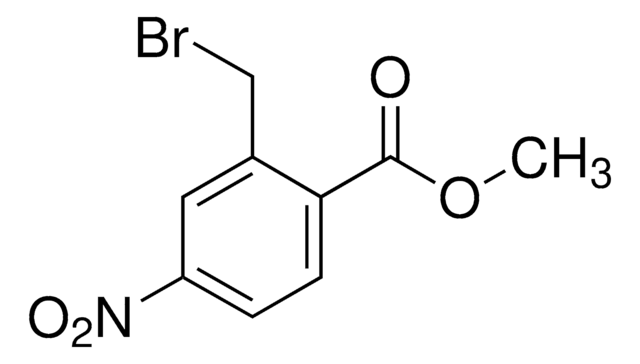162906
2-Hydroxy-5-nitrobenzyl bromide
90%
Sinónimos:
α-Bromo-4-nitro-o-cresol, 2-Bromomethyl-4-nitrophenol, Koshland I, Koshland’s Reagent I
Seleccione un Tamaño
Seleccione un Tamaño
About This Item
Productos recomendados
Ensayo
90%
Formulario
solid
mp
144-149 °C (lit.)
solubilidad
chloroform: soluble 25 mg/mL, clear, yellow
grupo funcional
bromo
nitro
temp. de almacenamiento
2-8°C
cadena SMILES
Oc1ccc(cc1CBr)[N+]([O-])=O
InChI
1S/C7H6BrNO3/c8-4-5-3-6(9(11)12)1-2-7(5)10/h1-3,10H,4H2
Clave InChI
KFDPCYZHENQOBV-UHFFFAOYSA-N
¿Está buscando productos similares? Visita Guía de comparación de productos
Categorías relacionadas
Descripción general
Aplicación
Otras notas
Palabra de señalización
Danger
Frases de peligro
Consejos de prudencia
Clasificaciones de peligro
Skin Corr. 1B
Código de clase de almacenamiento
8A - Combustible corrosive hazardous materials
Clase de riesgo para el agua (WGK)
WGK 3
Punto de inflamabilidad (°F)
Not applicable
Punto de inflamabilidad (°C)
Not applicable
Equipo de protección personal
Eyeshields, Faceshields, Gloves, type P3 (EN 143) respirator cartridges
Elija entre una de las versiones más recientes:
Certificados de análisis (COA)
¿No ve la versión correcta?
Si necesita una versión concreta, puede buscar un certificado específico por el número de lote.
¿Ya tiene este producto?
Encuentre la documentación para los productos que ha comprado recientemente en la Biblioteca de documentos.
Active Filters
Nuestro equipo de científicos tiene experiencia en todas las áreas de investigación: Ciencias de la vida, Ciencia de los materiales, Síntesis química, Cromatografía, Analítica y muchas otras.
Póngase en contacto con el Servicio técnico









